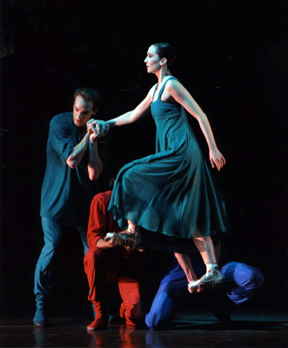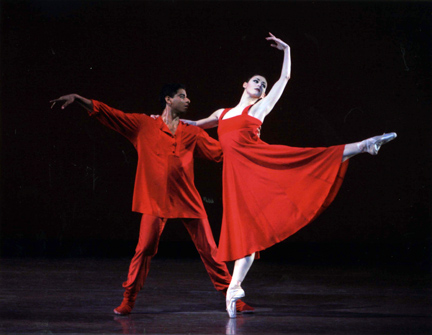Ratmansky's Diamond
“Monumentum Pro Gesualdo,” “Movements for Piano and Orchestra,” “Russian Seasons,” “Firebird”
New York City Ballet
New York State Theater
New York, NT
June 8, 2006
by Susan Reiter
copyright ©2006, Susan Reiter
 How refreshing to encounter, amid the flurry of NYCB premieres, a bold, confident new ballet that stakes out its own territory and does not remind one of anything else. From its first moments, Alexei Ratmansky’s “Russian Seasons,” a 35-minute work in twelve sections, seizes the eye and keeps one off guard with its unpredictable groupings, and from start to finish Ratmansky displays the courage of his convictions.
How refreshing to encounter, amid the flurry of NYCB premieres, a bold, confident new ballet that stakes out its own territory and does not remind one of anything else. From its first moments, Alexei Ratmansky’s “Russian Seasons,” a 35-minute work in twelve sections, seizes the eye and keeps one off guard with its unpredictable groupings, and from start to finish Ratmansky displays the courage of his convictions.
There are six couples, paired up by their solid-colored costumes: vivid, intense shades of green, blue, plum, cherry, orange and maroon. The men wear loose, long tops over leggings, while the women’s calf-length dresses hint at Russian folk styles of an earlier time (one can even sense a slight connection to the jumper-style dresses of “Les Noces”) but also have a no-nonsense contemporary look. Early on, Ratmansky establishes a communal pull between everyone, a sense that these are people mutually invested in something. Certain ones step forward and dominate the stage more than others, but he avoids creating a sense of hierarchy.
Ratmansky’s title is taken from his score, Ukrainian composer Leonid Desyatnikov’s 2003 work for violin, mezzo-soprano and string orchestra. Its dry, plangent melodies convey a connection to Russians folk melodies, yet feel stirringly original as well. The female voice is used sparingly, in five of the sections. The composer has drawn on the structure of Vivaldi’s “The Four Seasons” — four successive concertos of three movements each — and the press notes (but not the program) indicate the breakdown into Spring, Summer, Autumn and Winter. It’s a major, sophisticated score that engages the listener with an emotional pull, without ever coming across as manipulative, and one that certainly invites further hearings.
Between the intense colors of the costumes, including the small squarish hats with chin straps that the women sport at first, and the unpredictability of the entrances and alliances, the opening section is both riveting and disorienting. There is big, juicy movement to spare, and a constant sense of surprise. From the start, Ratmansky showcases the men in particular, giving them buoyant, sharply-etched phrases that sweep across the stage.
 But it is Sofiane Sylve, in bright crimson, who seems most on the choreographer’s wavelength. She seizes the stage whenever she appears, attacking her sharp, propulsive phrases with explosive energy. Everything she does is so clear and sharply etched that it lingers for a moment afterwards, and the sheer power she exudes is mesmerizing. The second movement, with its text an angry lament from a woman being married off to an older man, belongs to her, and one can only fear for the future husband of this vengeful Fury.
But it is Sofiane Sylve, in bright crimson, who seems most on the choreographer’s wavelength. She seizes the stage whenever she appears, attacking her sharp, propulsive phrases with explosive energy. Everything she does is so clear and sharply etched that it lingers for a moment afterwards, and the sheer power she exudes is mesmerizing. The second movement, with its text an angry lament from a woman being married off to an older man, belongs to her, and one can only fear for the future husband of this vengeful Fury.
In this section and often in the piece, Ratmansky has dancers weave through others in distinctly folk-flavored patterns. But this never feels forced or imposed. He finds a way to incorporate folk elements — and an earthy attack that veers more towards character dance at times — but with a smooth inevitability that never disrupts the ballet.
Wendy Whelan and Albert Evans emerge as the ballet’s “central” figures and most fully defined couple. She is the focal figure of the extended vocal section, one of the score’s most lyrical, in which a woman sees her friends celebrating and welcoming back their men from war, while her own “lad” has not returned. Whelan conveys the isolation and sense of abandonment, as the couples ripple through lifts and hover over her prone figure.
Overall, though, at this first performance, Whelan seemed the least at ease with Ratmansky’s smoothly designed, off-center movement. The other dancers seemed to slash through space like the bold lines of an abstract expressionist painting, but she lacked the same clarity of attack. Evans, however, imbued his passages a fantastically juicy expansiveness and exceptional alertness, delighting in their quick shifts and surprises.
Jennifer Ringer, who emerged most prominently during two sections in the “autumn” portion of the score, also looked invigorated by Ratmansky’s sharply accented, spiky demands. She filled each movement out lusciously and found quiet drama in her encounter with three men, who seemed to be guiding her along as she embarked on a voyage.
Ratmansky has a flair for punctuating the end of a section with abrupt surprises – couples slipping off almost unnoticed one by one into the wings, or a final hesitant dancer being pulled off. His invention rarely flags in their piece, and he keeps the stage picture energized but never overly busy. The ritualistic, somber final section is the only less-than-persuasive one. As the movement turns slow and melancholy, Whelan and Evans, now costumed in white, seem to become a sacrificial pair, surrounded by a now languid, wistful community.
The text for this “Closing Song” is deeply religious, suggesting the glory that exists in a world beyond our own. The entire score follows the quarterly rituals of the Orthodox Church, with such section titles as “Song for Whitsuntide” and “Song for Shrovetide,” and certainly a familiarity with that denomination’s traditions and celebrations would give greater insight into Ratmansky’s imagery and intentions. But even without that, one cannot help but feel deep chords of rich and fascinating emotion and suggestion being struck on a first viewing of this smart, ingenious and singular ballet. This one’s deifnitely a keeper.
Joining the premiere on this “all-Russian” program were repeats of “Monumentum Pro Gesualdo” and “Movements for Piano and Orchestra, again led by the languorously rangy Teresa Reichlen (in the former) and the coolly assertive Rebecca Krohn (in the latter), both partnered by an elegantly alert Charles Askegard. Sean Lavery’s “Romeo and Juliet” certainly offered a change of pace, and Yvonne Borree and Tyler Angle were duly sweet and quietly rapturous in this isolated balcony scene. Maria Kowroski, while beautiful and appropriately evoking the title creature’s wildness, somehow didn’t sparkle and blaze as one would wish in “Firebird.” Her hyperextended limbs didn’t slash and slice through the air with the right mercurial authority, and she also missed the necessary sense of danger.
Photos, both by Paul Kolnik:
Jenifer Ringer with Jonathan Stafford (hidden: Amar Ramasar, Sean
Suozzi)
Amar Ramasar and Sofiane Sylve
Volume 4, No. 23
June 12, 2006
copyright ©2006 Susan Reiter
www.danceviewtimes.com